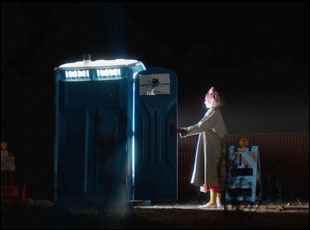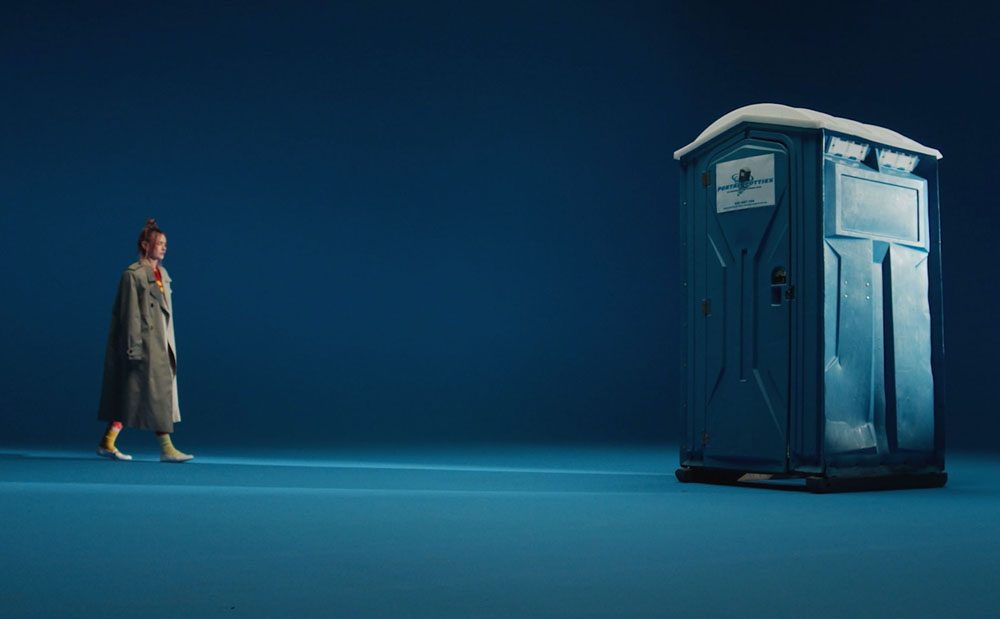If it were up to Gloria (Kate Jean Hollowell), she would tell her friend Ruby (Ruby Caster) not to go towards the lights upon being hit by a car in the early moments of “Say Hi After You Die,” but it’s advice she can’t heed herself upon seeing the warm glow of warning signs across the street from her house where a construction site appears to be telling her something. Ruby had joked that if she were going to be reincarnated, it surely would be as a port-a-potty and lo and behold, one sits outside her house as Gloria is in mourning, inclined to think it’s not so crazy to imagine that her friend is trying to send her a message from beyond the grave when her death itself is completely unfathomable.
“Say Hi After You Die” may be unbelievable as well, but only in the best of ways when Hollowell, a true force of nature as its star/director and co-writer along with Caster, turns the dark comedy into a transcendent bit of cinematic ecstasy, complete with a lavish musical number and style to spare. With no detail overlooked or too exuberant — the street corner sign thrower at the start of the 17-minute short has been ranked as the seventh best in the world — the story of a woman working out her grief inspires big emotions to highlight what’s often unseen when so many carry around a world of hurt that they’re loathe to share and beautifully conveys how no one is truly alone in their suffering, making the smallest sympathies shared between strangers feel like the grandest of gestures.
For the filmmaker who has built a following marrying serious music and dance moves to absurdist comedy under the moniker Number One Popstar, “Say Hi After You Die” has all the energy one might expect of her live performances with the craftsmanship she’s steadily accrued from directing music videos, leaving one dazzled even when the subject matter is grim. Shortly before “Say Hi After You Die” premieres at the Sundance Film Festival as part of Shorts Program 4, Hollowell spoke about summoning all the feelings with her latest work, pulling off an ambitious project in short amount of time and bringing out a real emotional performance from a port-a-potty.
On my birthday, my commercial directing agency called me and said, “Hey, we love you and we want to make any short film that you want to make.” Then weirdly, one of my good friends FaceTimed me ten minutes later and she’s a writer and I said, “I have a couple short film ideas that I’ve written, but why don’t you and I get together and write a short film?” And when she and I met up, we just started talking about reincarnation and the port-a-potty came up. Once we had that, we [thought], “This is kind of amazing,” and we just flushed out a really quick concept and shot it a month later, which is crazy.
I was trying to decide is all this construction equipment the easiest kind of thing to get your hands on for a production since it probably can be easily rented or is it difficult to pull together?
It turns out port-a-potties are very cheap to rent. I want to say $25 a week, something insane, and we actually shot the whole thing at my house to save money. I actually live on two acres and we staged it so that it looked like I was on a street and that was an empty lot across the street from the house, but that’s actually just part of the property, and if you rented a house and you’d [ask the homeowner] can we bring a giant bulldozer and leave a port-a-potty [in the yard] for a couple days, I think people would say no. But luckily, because I was the homeowner, we just did whatever we wanted.
You get so many great angles between the outside and inside of the home. Was it fun to think of where you live as a location?
I have to give credit to my DP Jordan Black, who when I was looking at locations, trying to find the perfect house, he was the one that suggested, “Why don’t you just shoot it at your house?” So we actually walked through and shot it on an iPhone because it was really important for the port-a-potty to be this symbol that was and something that I could see every time I’m looking out the window, like this ever-present thing that draws me. And we were able to find a way to make it really feel like that through angles. The house ended up being perfect because it’s up in the mountains of Los Angeles, but it doesn’t feel like L.A. and you don’t know where this is really and sometimes when you shoot in L.A., it just feels very L.A.
It seems like simplicity generally could be the most powerful. Before you’re invited into the port-a-potty, there’s that great scene of the flashing red light and the camera slowly panning in.
Yes, the port-a-potty on its own, just surrounded by nature felt very beautiful and I really love the shots of it just on its own, out in the field during the day and then at night. And the flashing lights definitely elevated it. Again, I have to give credit to my DP [because] we wanted the port-a-potty to beckon Gloria out to the field, like almost like a hypnotic pulse of lights. And that was definitely easier than the dance scene to shoot.
I don’t want to spoil that scene, but there is one and you’ve got Kat Burns, “My Crazy Ex-Girlfriend” choreographer, on board to choreograph. What was it like to work with her?
We were both on the same dance team. She was on a comedy dance squad that, and then by the time I joined, she had already left, but I had heard about her, and I had followed her and seen that she did all this really cool stuff, so when I started doing my own music videos, she actually messaged me and said, “Hey, if you ever want to collaborate, I know we never got to dance on the same team, but I’m a big fan of all your music videos.” And we put the short together in two weeks, from the time that we said, “Okay, we’re going to do it” and had the script to shooting it. So she choreographed that whole [musical number] in five days, which is so insane and she had maybe half a day of rehearsals, but she brought on so many talented, real professional dancers who could pick things up so quickly that they took it to a whole other level. It looks like we spent months planning that, but we didn’t even shot list it. We just winged it, and we only had one camera and we didn’t have a techno crane. We had someone operating a hand jib to get a lot of those giant shots that my DP knew, and he made it just look like a Hollywood dance number.

It was just a weird, natural progression that I don’t think I ever set out to be a filmmaker, but the more that I made things, the more I fell in love with it. I just kept pushing and if you watch my music videos, tonally and look-wise, I did a short film [“Are They Smiling?”] in 2020 for like $500 in 2020 that thematically is very similar to “Say Hi After You Die,” which is about grief and death — and there’s a surprise dance number. So over time, I went from doing that $500 short to then making my own music videos, which was a progression, and then started to do commercials, and the more you’re on set, the better you are as a director. Then I just found a way to direct myself and I never watched playback once. We just shot it and moved on because [“Say Hi After You Die”] was such an ambitious short that there was like no time for me to approve the shot [or do] the four takes and decide if it was good to move on. We just really just had to. So it was almost a surprise to me when I got the first cut from my incredible editor Talia [Pasqua], that I thought, “Oh, wow, it works.”
I can’t disagree, and one of the things that stands out in nearly all your work is that you always come up with these great costumes and it seems like building the characters may start off there. What it was like to work with the wardrobe on this?
Jordy [Scheinberg], the stylist on this is amazing, and one thing she brought to the table that I thought was really interesting was establishing a color for Gloria and then a color for Ruby, so it’s maybe not something that you notice right away, but if you watch it a couple of times, you’ll start realizing that Ruby is wearing blue and then the port-a-potty’s blue, and then my character’s always wearing some shade of red incorporated, and by the end of the film, I’m wearing blue as if I’m remembering her through that or she’s a part of me. That was like a really interesting creative idea that Jordy brought to the table, which even if you don’t notice it, I hope that people somehow feel that.
What was it like to find out it got into Sundance?
Utter shock. I have to be honest, I wrote it off. I just assumed it was not tonally [right] for Sundance, and when I got the call from my producer [saying] that they wanted it in the program, this is so embarrassing, but I started crying because you work so hard on something, and this is such a weird concept, but through and through it’s an expression of me as an artist because co-wrote it, directed it, and [act] in it. And you put so much love and heart into stuff, and so many people do that and they don’t ever get the exposure that it deserves, so it’s just exciting that Sundance saw it and appreciated it. That’s really cool.
“Say Hi After You Die” will screen at the Sundance Film Festival as part of Short Film Program #4 on January 21st at 12:15 pm at Prospector Square Theatre in Park City, January 22nd at 5:30 pm at the Megaplex Theatres at the Gateway in Salt Lake City, January 25th at noon at the Redstone Cinemas in Park City, January 27th at 4 pm at the Megaplex Theatres at the Gateway in Salt Lake City and January 28th at 1:30 pm at the Holiday Village Cinemas in Park City. It will also be available to stream from January 25th through 28th.





